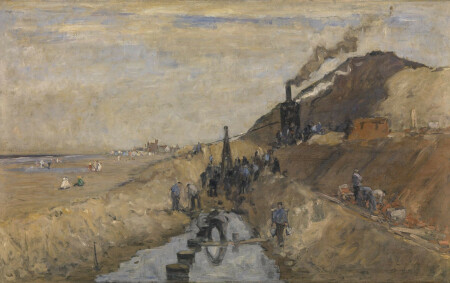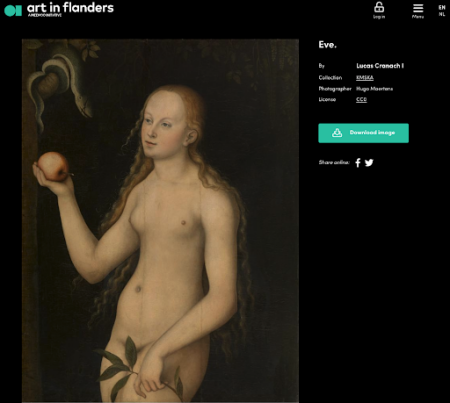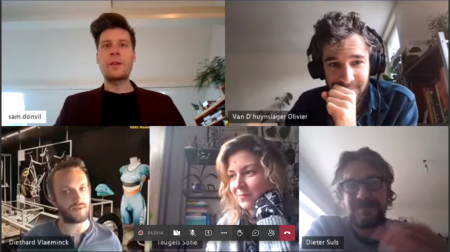Public Domain Day 2022
- Record
Public domain collections are collections that can be accessed online without any issues, which makes them ideal for starting to implement your open data policy. Every year, Public Domain Day offers organisations in the heritage sector a platform where they can share their achievements, challenges and visions for providing access to collections which are no longer protected by copyright. We organised a webinar around these issues on 10 February – together with the KBR (Royal Library of Belgium), Wikimedia Belgium, Ghent University Library and Collections of Ghent.
On 10 February 2022, we celebrated the seventh edition of Public Domain Day in Belgium with a well-stocked online programme and 68 attendants. We welcomed speakers from Creative Commons, the Royal Library of Belgium, MoMu Fashion Museum of Antwerp, KOERS Museum of Cycle Racing, Design Museum Ghent, the Collections of Ghent, and of course meemoo itself. Wikimedia Belgium also launched its Wikimedian in Residence project, which will help institutions to make their collections accessible on Wikimedia platforms.
What and why?
The public domain is the collection of all creative works that are not subject to exclusive intellectual property rights, such as copyrights and other related rights. A new group of works becomes available in the public domain on 1 January every year in Belgium, where copyright protection expires 70 years after the death of the creator.
Content in the public domain is therefore perfect for inclusion in your open data policy and making available for re-use. With Public Domain Day, we’re providing organisations in the heritage sector with a global platform to exchange good practices and publicise their public domain plans and achievements.
Public Domain Day 2022
Watch the recording of Public Domain Day 2022 here:
Don't see a video? Please check your cookie settings so we can show this content to you too.
Edit your cookie preferences hereCan’t see the video? Please check that your cookie settings allow us to show you this content. You can change your cookie settings at the bottom of this page. Click on ‘Change your consent’ and select ‘Preferences’ and ‘Statistics’.
Good practices for rights information - Creative Commons
Creative Commons is a non-profit organisation that aims to remove legal obstacles that can get in the way of sharing knowledge and creativity. With this goal in mind, they’ve developed licences which allow copyright holders to make their creations – and therefore content protected by copyright – more openly available and legally re-usable by other creatives. They also support the GLAM (galleries, libraries, archives and museums) sector in making their collections more accessible. The heritage sector makes extensive use of the Creative Commons tools, but not always in the correct way. CC BY licences, for example, are often used to ensure that the name of the institution or photographer who made the reproduction is stated, even though neither are the authors of the work. So it’s a bad practice.
Camille Françoise from Creative Commons came to talk briefly about the good practices that her organisation is focusing on in 2022 – in particular the distinction between CC0 and the Public Domain Mark, which are often confused with each other even though they’re actually different. CC0 is a waiver that allows the work that you own the copyright for to be placed in the public domain. The Public Domain Mark, on the other hand, is neither a licence nor a waiver but a communication tool – it’s a label or tag to indicate that a work is in the public domain. One current poor practice is using CC0 even when the work is no longer protected by copyright. Despite the fact that it’s the institution’s intention to indicate that they want to make the object openly accessible, it constitutes an unjustified claim to rights. In this case, the good practice is to use the Public Domain Mark. Camille invited the Public Domain Day participants to complete a survey about this.
OpenGLAM showcase
Then followed the OpenGLAM showcase: an annual platform for the heritage sector to present their progress in making public domain collections openly available. It’s the ideal moment for them to share how they have made their public domain collections accessible and facilitated their re-use.
Meemoo colleague Sam Donvil kicked things off with an update on the uploading of images from the collection from the Museum of Fine Arts in Ghent (MSK). In autumn 2021, meemoo welcomed Sofie Van Bever as an Information Management graduate intern from Artevelde University of Applied Sciences to help us make progress in uploading collections – in line with meemoo’s KPI to make all public domain images available in the artinflanders.be images database. The MSK were very positive about this initiative and Sofie took care of preparing the images. However, because the Wikimedia Commons image upload tool, Pattypan, wasn’t working until two days before Public Domain Day, the upload wasn’t completed until February 2022.
This update was also a good opportunity to highlight new features in Wikimedia’s tooling. In addition to the new Pattypan upload tool release, following the implementation of structured metadata – to improve searchability in the image database – the images database has now also had a query (or search) service since February 2022, which you can use to look up 80 million images on Wikimedia Commons using SPARQL queries. Try the query service here. You’ll find several examples by clicking on the ‘examples’ button.
Wikimedia is also choosing to integrate more of its tooling in the OpenRefine data cleaning tool. Over the course of 2022, not only will it become possible to upload structured metadata to images on Wikimedia Commons; you will also be able to upload via OpenRefine – greatly streamlining the whole upload workflow. Click here for more information.
As it does every year, the Royal Library of Belgium has delved into its collections to see which makers’ works will find their way to the public domain in 2022. Sébastien Hermans presented a selection of under-catalogued etchings, prints and drawings by three Belgian artists who died in 1951, which have now all been catalogued and digitised in advance of Public Domain Day. Finally, items were created on Wikidata for 69 works, with images uploaded to Wikimedia Commons:

Image: ‘Dijkbouw aan het strand van Knokke’ (Dyke construction on the beach in Knokke), Richard Baseleer, KMSKA (Royal Museum of Fine Arts Antwerp), photo by Dominique Provost, via artinflanders.be, still currently CC0 – soon to be Public Domain Mark
Hermans’ colleague Piet Janssens then showed their selection of 50 under-catalogued tourism guides by Maurice Cosyn. Public Domain Day helped these guides to be catalogued and uploaded to Wikimedia Commons in 2021-2022. The collection consists of 50 covers and 101 maps. These walking routes described by the pioneering Cosyn laid the foundations for modern trails, including several ‘Grote Routepaden’ (Long-Distance Trails) (link in Dutch). The Wikidata items that represent these guides are now also linked to Wikidata items on existing walking trails.
Following the Royal Library of Belgium, it was the turn of meemoo colleague Ellen Van Keer. She explained how we’re updating the process for displaying rights information on artinflanders.be. The reason for revising this policy is that metadata provided for the art and heritage image database often contains inconsistencies. The guiding principles we aim to follow for this are:
‘to be as open as possible’ by avoiding new rights claims on digital surrogates of public domain work, in accordance with the EU Directive and what has actually already been adopted in Belgian jurisdiction;
‘to be as closed as strictly necessary’ where there is a legal basis.

Image: current situation on artinflanders.be. In future this will become the Public Domain Mark
What this means, exactly, is that meemoo is moving away from using CC0 when a Public Domain Mark is more correct. We’re also getting rid of the copyright symbol – to encourage name attribution. When artinflanders.be is contractually obliged to make a work less open, we no longer use the CC-BY-NC-ND licence (to enforce that no derivatives can be made and that commercial use is not allowed). There is no legal basis that allows the use of this licence for public domain content because there is no copyright. In this case, it is more correct to use the ‘NO COPYRIGHT - CONTRACTUAL RESTRICTIONS’ rights label. If it concerns a three-dimensional piece of work, then copyright does apply for its reproduction under Belgian law, however.
Because artinflanders.be contracts often ask for attribution, the best option is currently a CC-BY licence, which requires name attribution of the photographer. In future, we’re also aiming to work towards:
CC0 for reproductions of 3D works, which legally amounts to the same thing as the public domain;
Public Domain Mark for reproductions of 2D works, where attribution is not enforced but encouraged.
This will ensure that the reproduction also remains a public domain work – made using public money, after all – in the digital realm of the public domain. These changes mean that artinflanders.be will also need to adapt, and photographers’ contracts will also need to be revised. Finally, we also want to encourage user involvement by creating a support base among our (content) partners.
Following this explanation, meemoo colleague Bart Magnus gave us a provisional update after one year of the Public Domain Tool. This tool helps to determine the rights status of a collection – thanks to Wikidata – and to share the information on Wikidata. Bart then also explained which projects set up to deal with the backlog of digital collection data will make use of the Public Domain Tool, and which are planned for upload to Wikimedia platforms.
Panel discussion
Since European copyright laws were reformed, it has started to become the norm – at institution and government level – to provide access to reproductions of public domain works without new restrictions. We therefore wanted to focus on strategy and practice in this edition: why and how can you share public domain collections? In the panel discussion, four members of the panel outlined specific initiatives that their organisations are undertaking to actively facilitate the (creative) re-use of their collections.

Image: panel discussion between Sofie Teugels, Diethard Vlaeminck, Dieter Suls and Olivier Van D’huynslager, hosted by Sam Donvil.
In the panel discussion, each speaker gave a lightning talk to explain their practice. Sofie Teugels described the Collections of Ghent project, which as well as providing access to collections from five Ghent institutions, is also making efforts to encourage their re-use. The Cultural Data Lab, for example, is being used for experimenting, knowledge sharing and building a community. There’s also the ‘Co-creation fund’ (link in Dutch), which provides financial support for creatives to re-use collection data.
Diethard Vlaeminck from KOERS showed how this Museum of Cycle Racing located in Roeselare is aiming to reach its potentially global audience using digital means. KOERS wants to serve an international audience by offering collections on various platforms and linking to social media. They’re also paying attention to using multiple languages by experimenting with Wikimedia platforms. In addition to their organisation’s website, they also have the serviceKOERS platform, which will ultimately become not just a virtual museum with cycle racing stories, but also a good starting point for researching cycling history and a platform for other collectors. They want to provide access to their own and others’ collections here, and showcase their own and others’ research, as well as stimulating the (creative) re-use of collections.
Dieter Suls from MoMu explained how the fashion museum organised an experimental pattern-a-thon at the end of 2021. Museum collections aren’t always accessible in the ways that specific user groups need. As a fashion museum, however, they want to make their study collection available on Wikimedia platforms together with their fashion thesaurus (link in Dutch). This is because designers can’t simply (re-)use reproductions straight away; they need to have template patterns. The museum therefore organised a workshop to create these patterns together with members of their community of (re-)users. The participants then agreed that the patterns could be posted on Wikimedia platforms under a free licence so that they can be (re-)used. This was an experiment within the Citizen Heritage project on citizen science; they are investigating whether this format can also be set up elsewhere.
The panel discussed the following topics and questions:
Restrictions imposed within the context of the coronavirus pandemic were a perfect test to see if the heritage sector is digitally mature. But was the Belgian heritage sector prepared? Was your organisation prepared? Had you already made any efforts previously which you then benefited from?
How do you determine which audiences you want to focus on and how do you find them?
People often speak about the explosion in creativity that providing free access to (public domain) collections will stimulate. Is it naïve to expect that this will happen simply by posting collections online to create a good impression, without actively facilitating it?
Wikimedian in Residence (WiR)
Wikimedia Belgium ended the day by announcing the winners of their annual Wiki Loves Heritage photo competition. This initiative – just like the globally organised Wiki Loves Monuments and Wiki Loves Art (which was organised together meemoo’s predecessor PACKED vzw in 2016) – is a way to increase the visibility of Belgian heritage. Photographers are requested to post their work on Wikimedia Commons under a free licence so it can be freely re-used both on Wikimedia platforms and elsewhere. The globally organised Wiki Loves Monuments will also be organised under this name in the future, following the example set by Wiki Loves Heritage. This will mean that movable, intangible and scenic heritage are also eligible in addition to immovable heritage.
Finally, Wikimedia Belgium presented the Wikimedian in Residence initiative. This involves the Wikimedia Foundation going in search of museums and heritage institutions that would like to employ a Wikipedian – with the help of donations from Friends of Wikimedia Belgium Fund – on one hand to upload content to Wikimedia platforms, and on the other to organise activities to improve the visibility of these digital collections and increase their re-use. Wikimedia Belgium will select three projects to support in the autumn of 2022, with funding amounting to approximately €5,500: equivalent to the wage for a BIS professional vocational internship in Flanders and a FOREM professional vocational internship in French-speaking Belgium. If your organisation is interested in being a part of this initiative, please submit your project proposal to projects@wikimedia.be before 30 April 2022.
The project proposal must address the following issues:
A description of the project and what it’s for;
The envisaged outcomes;
The project planning and budget;
An administrative plan to indicate how the WiR will be employed, paid and insured. This is because Wikimedia Belgium cannot put any personnel on their own payroll.
Next steps
Do you want to get started with making works from your own collection accessible in the public domain? As we did in 2021, meemoo is again organising two workshops for Public Domain Day in 2022 for you to present your own achievements – just like the institutions mentioned above:
On 17 February 2021, we organised a Public Domain Day rights workshop (link in Dutch): consisting of a seminar about all the relevant legal aspects relating to the public domain, and a workshop to get started with using the Public Domain Tool. You can watch the recordings (link in Dutch) or consult the slides.
You’ll be able to follow the Public Domain Day series of upload workshops in the autumn – when we’ll explain the entire workflow for uploading data to Wikidata and images to Wikimedia Commons.
